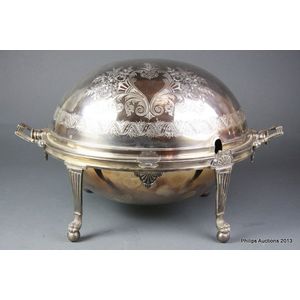19th Century Sheffield Plate Food Warmer
A Sheffield plate food warmer, by John round & Son, mid to late 19th century, oval domed warmer with bright cut floral and foliate sprays to the hinged roll lid and a continuous ribbon and fern pattern encircling, with fluted side handles and supported on conforming legs with claw and ball feet; with internal tray; marked underside and also with trademark stamp 'All the Round'. Height 24 cm. Length 38 cm. Depth 25 cm
You must be a subscriber, and be logged in to view price and dealer details.
Subscribe Now to view actual auction price for this item
When you subscribe, you have the option of setting the currency in which to display prices to $Au, $US, $NZ or Stg.
This item has been sold, and the description, image and price are for reference purposes only.
- Foliate - Decorated with leaves or leaf-like forms.
- Sheffield Plate - Sheffield plate was the first commercially viable method of plating metal with silver. The method of plating was invented by Thomas Boulsover, a Sheffield Cutler, in 1743 and involved sandwiching an ingot of copper between two plates of silver, tightly binding it with wire, heating it in a furnace and then milling it out in to sheet, from which objects could be made.
Originally used by its inventor to make buttons, the potential of the material was quickly realised, and soon it was being used to fashion boxes, salvers and jugs, and not long after that candlesticks and coffee pots, and other traditional tableware.
Although there was a considerable saving in the amount of silver used, Old Sheffield Plate manufacture was more labour intensive than solid silver, meaning higher labour costs. This meant that Old Sheffield Plate was very much a luxury product, and only available to the very wealthy.
The thickness of the silver means that many 18th century Sheffield Plate pieces still have a good layer of silver, while electroplated pieces (EPNS), may have been replated several times over their lifetime. Where the silver has worn off the Sheffield plate the soft glow of the copper base can be seen underneath. However this is not an infallible guide that the piece is Sheffield Plate, as many EPNS items were also plated on to a copper base.
Most Sheffield plate items are unmarked, whereas most elecroplated items display manufacturers names or marks, quality indications such as "A1", "EP", together with pattern or model numbers.
Sheffield plate was made commercially between 1750 and 1850.
This item has been included into following indexes:
Visually similar items

19th century silver plate domed food warmer, in neo classical taste, accented with garlands and rams heads, raised on four hoof feet, 25 x 39 x 28 cm
Sold by
in
for
You can display prices in $Au, $US, $NZ or Stg.

19th century Epns warming tureen
Sold by
in
for
You can display prices in $Au, $US, $NZ or Stg.

An Angus & Coote, Sydney silverplate rollover steak dish, 20th century. 22 cm high, 34 cm wide, 26 cm deep
Sold by
in
for
You can display prices in $Au, $US, $NZ or Stg.

A Victorian plated bacon dish, with revolving cover chased decoration on four feet
Sold by
in
for
You can display prices in $Au, $US, $NZ or Stg.
